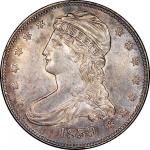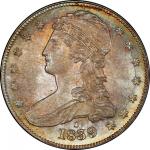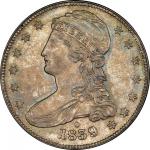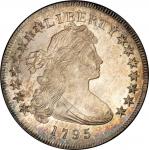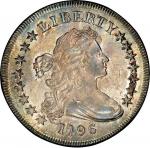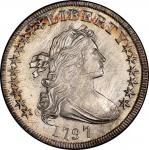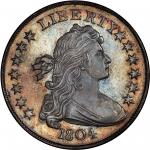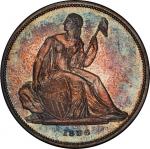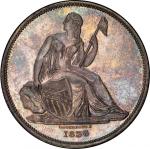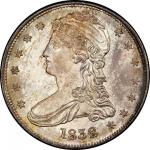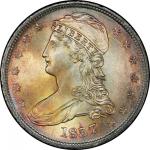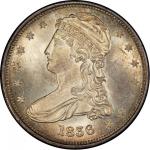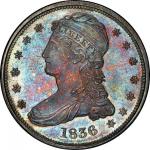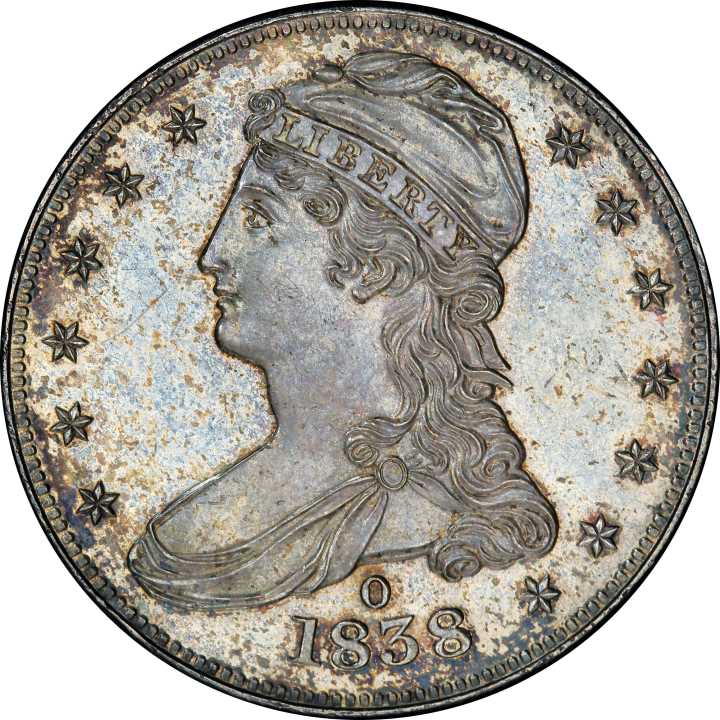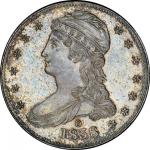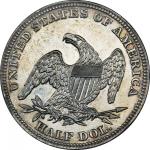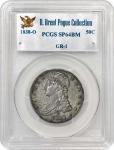They are not merely among the rarest Mint Marks, but the rarest pieces of United States coinage” — Augustus Heaton, A Treatise on the Coinage of the United States Branch Mints, 1893</em>There is a short list of American coins whose rarity and legend need no introduction. Among half dollars, there is only one of these signal rarities: the 1838-O. The story of its genesis coincides with that of the New Orleans Mint, the first branch mint to strike silver coinage. Just 20 are thought to have been struck, and only nine are known to have survived to the present day. Strictly judged on the merits of such a tiny population, this would be a famous and special issue, but its history and special production gives the 1838-O half dollar further layers of desirability.Like all 1838-O half dollars, this coin was specially struck to accentuate its detail, coined with a finish to make it stand out among other half dollars of its type. Today, the 1838-O halves are called “Specimens,” a modern term to acknowledge their distinctive minting procedure and texture, though in the past they have often been called Branch Mint Proofs. The fields are reflective, displaying a handcrafted surface that is neither frosty like typical half dollars of this era struck for circulation, nor mirrored like Proof half dollars coined in Philadelphia for presentation or sale to collectors. From this smooth surface, the devices stand out with exceptional boldness. Each star not only has central detail, its angles are taut and its points are sharp. The portrait of Liberty is presented in rounded, sculptural relief; her hair is engraved with the fineness of terracotta incised with a reed while still wet. The denticles are individually formed and stand apart from the rim. The reverse shows every engraved contour of the eagle, from beak to talons, a textbook on how this design type would look if the engraver’s sketch became manifested into metallic reality. The strike was so forceful as to create a wire rim, called a “fin” in the mint terminology of the era; seen as a striking imperfection by the coiners of that time, the fin was diminished before release, but is still somewhat visible around the reverse. Beautiful pale blue shades have gathered to the obverse fields, offset from the peripheries by dappled gold and contrasting with the glossy even pewter gray of the devices. The reverse is a deeper and more even silver gray, but yields attractive light blue and deep gold tones under a light. A few minor marks are seen on the obverse, including a thin scratch inside of star 3 and a few contact points between Liberty’s hair and star 10. Faint hairlines are present, more evident on the reverse than obverse. A jogging sequence of small marks begins under IT of UNITED and extends to beneath ST of STATES. The overall aesthetic impression of the superb color and distinctively sharp strike is uniquely appealing, giving this half dollar a look matched by no other issue of this design type or any other. Among specimens of the 1838-O, many of which have been carelessly handled, this ranks within the top echelon of survivors.The light cracks around the reverse show that the 1838-O half dollars were coined from the same reverse die as the 1839-O GR-1 halves, but in a much earlier die state. A very fine crack connects the bases of ED in UNITED, and another arcs from the midsection of E of AMERICA through the bases of the nearby RI and the left side of C to the rim beyond. A short, thin crack from the base of I in AMERICA doesn’t appear to reach the adjacent wing. The fine network of cracks that pass through the leftmost leaf cluster are visible, reaching the wingtip above to the top, the denticles on the left, and extending below to HAL of HALF. Raised die polish lines cover much of the reverse fields, running on a diagonal, just removed from vertical, from southeast to northwest. These are particularly easily seen above the arrow shafts, under the eagle’s beak, and off the wing at left.On March 3, 1835, Congress appropriated $200,000 for the construction of a mint at New Orleans, Louisiana “for the coinage of gold and silver.” The act also authorized $50,000 each for construction of mints at Charlotte, North Carolina and Dahlonega, Georgia, facilities that would be authorized to coin only gold. In Section 4 of the act, the mints were placed “under the control and regulation of the director of the Mint at Philadelphia,” who would be responsible for ensuring there was a method of “discriminating the coin which shall be stamped at each branch” while also “preserving uniformity of weight, form, and fineness in the coins stamped at each place.” Letters were chosen to represent each of the branch mints, to be placed conspicuously on each coin. Unlike France, which made the mother mint in Paris “A” while other mints were represented with B, C, and others in sequence, the branch mints of the United States would be known by letters that abbreviated the name of their city. The coinage of the branch mint in New Orleans was to be marked O.The first coins struck with an O mintmark were dimes, coined in May 1838. While dimes were useful for local small change, half dollars were the largest and most important silver coins then in common circulation. Enormous quantities of foreign silver coins were imported into the United States via New Orleans, mostly from Mexico and the West Indies. Only full scale production of large denomination silver coins like half dollars could efficiently convert the flow of uneven quality Latin American silver coins into a sufficient quantity of new United States coins fit for banking and commerce. Thus, half dollar coinage became a primary goal of the New Orleans facility.As with so many grand plans, the beginnings of the New Orleans Mint were problematic. With a fine new structure, and a fresh allotment of dies sent from the mother mint in Philadelphia in separate packages on April 9 and April 11, the technical footings were set for success from the day the mint opened. Twelve dies were received in the mail from Philadelphia on May 3, representing two pairs of dies for half dimes, dimes, and half dollars. Dimes were put into production first, with a run of 30 pieces on May 8. These dimes were mostly reserved for presentation, including one mailed to Philadelphia Mint Director Robert M. Patterson on May 12. The small press used to make dimes encountered difficulty soon thereafter, forcing an interruption in dime production. Repairs were undertaken, and dime coinage resumed for a short time in early summer, before another calamity hit: yellow fever. The late summer scourge closed the Mint’s doors for all of August, September, and October 1838. After reopening in November, the first half dimes were struck, a production run that continued after the beginning of the New Year. 1838 had come and gone, and not a single half dollar had been struck.On January 17, 1839, Mint Director Patterson wrote to New Orleans Mint superintendent David Bradford, cautioning “no time should be lost in getting ready for the coinage of half dollars.” “Dimes and half dimes count too slowly,” Patterson added, “and keep your account of coinage too low.” Dime and half dime coinage continued apace in early 1839, as a February 25 letter indicated that “we are averaging more than 25,000 pieces per day,” but officials at both Philadelphia and New Orleans recognized that there could be no substitute for half dollar coinage, and it must begin as quickly as possible.The February 25, 1839 letter from Coiner Rufus Tyler to Patterson is the first to mention the coinage of 1838-O half dollars, and it makes clear that the first 10 coins were produced as test strikes. Tyler pointed out that the dies sent the previous year were now “unsuitable for present use, for besides being out of date, the bottom ones are too short to reach the screws and consequently cannot be secured in the seat.” The dime press was far too small for half dollars, and the half dollar press was not yet in working order, so Tyler had attempted to mount the half dollar dies in the largest press, intended for dollars. Too short to fit in this largest press, the half dollar dies must have resembled children in a full sized chair with their legs not able to touch the ground. Tyler, an ingenious mechanic, remedied this with a temporary solution, affixing a piece on the bottom of the die body to make it rest more comfortably in the press. “I have however spliced one of them in order to try the press and succeeded in making ten excellent impressions; the very first one struck, being as perfect as the dies, and extremely satisfactory, but the piece upon the bottom of the die became loose and I was unable to strike any more without further fixing.” Superintendent Bradford followed with a letter two weeks later, on March 7, which more precisely identifies when the first 10 1838-O half dollars were struck. “About the middle of January Mr. Tyler struck a few pieces – half dollars – in the large press [the dollar press]. He informed me that the half dollar dies that had been received at this Branch Mint were made for Mr. Eckfeldt’s press [the half dollar press] and were too short for the large press.” Bradford described Tyler’s fix, but noted that the “member fitted to supply the length” had been “crushed after striking a few pieces.” Bradford’s letter went off to Philadelphia in the mail, and as it went north, the new 1839 half dollar dies headed south. Patterson had forwarded two pairs of dies to Secretary of the Treasury Levi Woodbury to send on to New Orleans on March 12, 1839. On March 29, 1839, David Bradford wrote Patterson from New Orleans to let him know that his last two letters “were before me,” having apparently just arrived that day, and “the pair of half dollar dies you sent on the 12th have also arrived.” Bradford’s first body paragraph sounds apologetic, as if covering himself while reporting the directions he gave to coiner Rufus Tyler: “I stated to Mr. Tyler that you advised that the dies of 1838 be not used and I suggested that it would be best to return them to you … but he thought it not worthwhile.” Just a few lines later, Bradford reported some good news: “Mr. Tyler has got the half dollar coining press in operation. He commenced striking on the evening of the 27th inst[ant] and the press is now performing admirably.” In light of the letter’s opening, it seems that the first half dollars struck on the half dollar press were struck with the 1838 dies, representing a second batch of 1838-O half dollars in addition to the 10 coins Tyler had coined in January.The historical record then fell silent on the production of the first New Orleans half dollars, a rarity from the moment they were made. 1839-O half dollar production started within days of the last 1838-O halves being coined, and some authorities have suggested that the die state of at least one 1838-O half dollar (the Smithsonian specimen) is actually later than the earliest state seen on the 1839-O halves, most of which were struck with a leftover 1838 reverse die. In 1894, Ed. Frossard offered an 1838-O half dollar with an original transmittal note from Rufus Tyler that filled in more of the story of their production. As recounted by Frossard in<em> The Numismatist </em>in July 1894, the letter read: “The enclosed specimen coin of the United States branch mint at New Orleans is presented to Pres. Bache by Rufus Tyler, the coiner. It may be proper to state that not more than twenty pieces were struck with the half dollar dies of 1838.” The mintage figure of 20 coins that has become commonplace in modern literature comes from this source, but Tyler does not say 20 were coined, rather, he says “not more than twenty.” Ten were coined, by Tyler’s own accounting, in January 1839. A few more were apparently struck in March 1839. The exact number remains unknown.The question of how many exist today is similarly difficult to pin down. Most census listings have fixed the number extant between nine and 11 specimens, including the Mint Cabinet specimen in the Smithsonian Institution. Few of the modern census compilations have accounted for a story told by Q. David Bowers on page 158 of his <em>1986 United States Dimes, Quarter, and Half Dollars: An Action Guide for the Collector and Investor.</em> “A rather tragic occurrence involving an 1838-O half dollar happened around 1960,” Bowers recounted. “A young collector, who lived in Philadelphia’s Main Line area, acquired a beautiful specimen. One evening fire struck his home, and the collector, 1838-O half dollar, and other items perished.” The lightly worn example from the 1953 Guggenheimer sale has not resurfaced since that time and appears to be distinct from other listings. The Pogue example can be traced to 1908 with good documentation. In September 1908. H.O. Granberg of Oshkosh, Wisconsin displayed this coin at the American Numismatic Association convention in Philadelphia. In 1914, he displayed it at the now legendary exhibition at the American Numismatic Society, and it was photographed for the exhibition’s catalog. According to an article about the exhibition in the April 1914 issue of <em>The Numismatist,</em> Granberg’s display was “the most interesting and general of the entire exhibition, on account of embracing so many rarities of the various series.” The coin was acquired by Waldo Newcomer soon after Granberg displayed it in New York, and it remained in the Newcomer collection until about 1931, when B. Max Mehl acquired most of the Newcomer coins. Plates made by Mehl depict this coin, and Mehl’s advertisement in the March 1932 issue of <em>The Numismatist</em> likewise illustrates it. Mehl apparently sold it to Col. E.H.R. Green. The next owner, Maurice A. Ryan, recorded the Green provenance, but not from whom exactly he purchased it. From Ryan, the coin sold to Will W. Neil of Abilene, Kansas, and its modern provenance since B. Max Mehl’s 1947 Neil sale is well attested. For most of the 1930s through 1950s, this coin was illustrated in Wayte Raymond’s <em>Standard Catalogue of United States Coins,</em> duplicated from the photograph in the 1914 ANS exhibition catalog.Col. E. H.R. Green has been credited by various authors as owning either six or seven specimens. Research by Saul Teichman among the Burdette G. Johnson invoices following Johnson’s acquisition of Col. Green’s half dollars on June 30, 1942, has found four listings for an 1838-O half dollar. One was offered to F.C.C. Boyd on August 5, 1942, for $1,100; this appears to be the Boyd-Oviedo-Byers specimen, now graded PCGS Branch Mint Proof-50. Stack’s was invoiced for another on August 20, 1942, priced at $1,200, and described as a “perfect brilliant proof.” The Stack’s coin was marked paid on December 7, several weeks before the other coins on the same page were paid for, which suggests Stack’s already had a customer in mind. James Macallister was offered two on the same invoice, dated September 9, 1942, an “extremely fine to Uncirculated” coin at $875 and a Proof at $1,200 that was described as a “steel colored proof.” There is a possibility the number attributed to Green’s collection conflates the coins in his hoard with the two owned by Virgil Brand. Burdette Johnson appears to have handled two 1838-O halves from Brand’s collection in 1941, before acquiring the Green coins. Brand was the underbidder on the coin sold in the February 1903 sale conducted by the Chapman brothers. Purchased by George Woodside for $190, the coin may have found its way to Brand later, as some authorities note he acquired an 1838-O in 1903 for $250, but Saul Teichman suggests Woodside may have served as an agent for Dewitt Smith, whose collection of silver coins was later purchased by H.O. Granberg.The description B. Max Mehl penned of this coin for his 1947 sale of the Will W. Neil Collection included two mutually exclusive provenance chains for this coin. The first explains that the previous owner, Maurice A. Ryan, “secured it from the Colonel Green Collection, who obtained it through me from the celebrated Waldo Newcomer Collection of Baltimore.” This provenance is well proven, via Mehl’s illustrated advertisement of coins from the Newcomer Collection in the March 1932 issue of <em>The Numismatist</em>. At the end of the same 1947 description, Mehl details a “memo enclosed with this coin when I received it from Mr. Neil [stating] that this coin is from the Colonel Green Collection ... and that he paid the late Henry Chapman $2,000.00 for it in 1928.” Col. Green could not have acquired this one from Henry Chapman in 1928 if B. Max Mehl had it in 1932. The note Neil had must have accompanied one of Green’s other 1838-O half dollars, but it has been confusing researchers and catalogers ever since.Among the nine coins confirmed to exist, none have been graded finer than this coin. Seven discrete specimens appear to have been graded: this coin, as Branch Mint Specimen-64 (PCGS); the Eliasberg coin, Branch Mint Proof-64 (PCGS); the Baldenhofer coin, Branch Mint Proof-64 (PCGS); the Norweb coin, Proof-64 (NGC); the Atwater coin, Branch Mint Proof-63 (PCGS); the Boyd-Byers coin, Branch Mint Proof-50 (PCGS); and the Anderson-Dupont coin, Branch Mint Proof-45 (PCGS). The Cox-Robison coin and the Haines-Empire coin appear to remain uncertified; the Mint Cabinet coin in the Smithsonian will hopefully always remain so. The New Orleans Mint, despite its stuttering start, went on to decades of preeminence among the United States branch mints. Hundreds of millions of half dollars were struck between January 1839 and June 1909, when the New Orleans facility struck its last. Only the half dollars of 1838 and 1839 featured their mintmarks in a position of prominence on the obverse. The special circumstances of the production of 1838-O half dollars, along with its infinitesimal mintage figure, have made it a rarity full of drama and mystery. Through the efforts of modern researchers, including R.W. Julian, David Stone, Mark Van Winkle, Kevin Flynn, and Saul Teichman, much of the mystery has been elucidated by documented facts, but this most desirable issue of the New Orleans Mint remains all the more dramatic now that its story has been fully told.PCGS# 6226.

